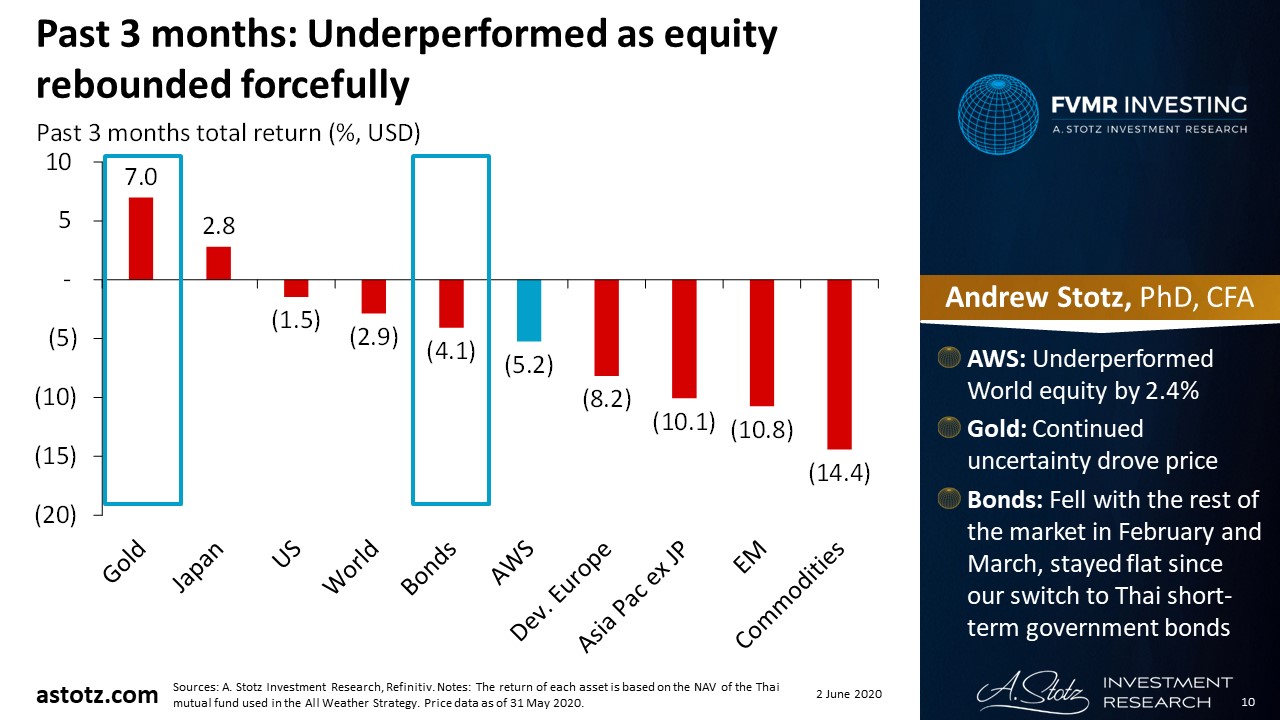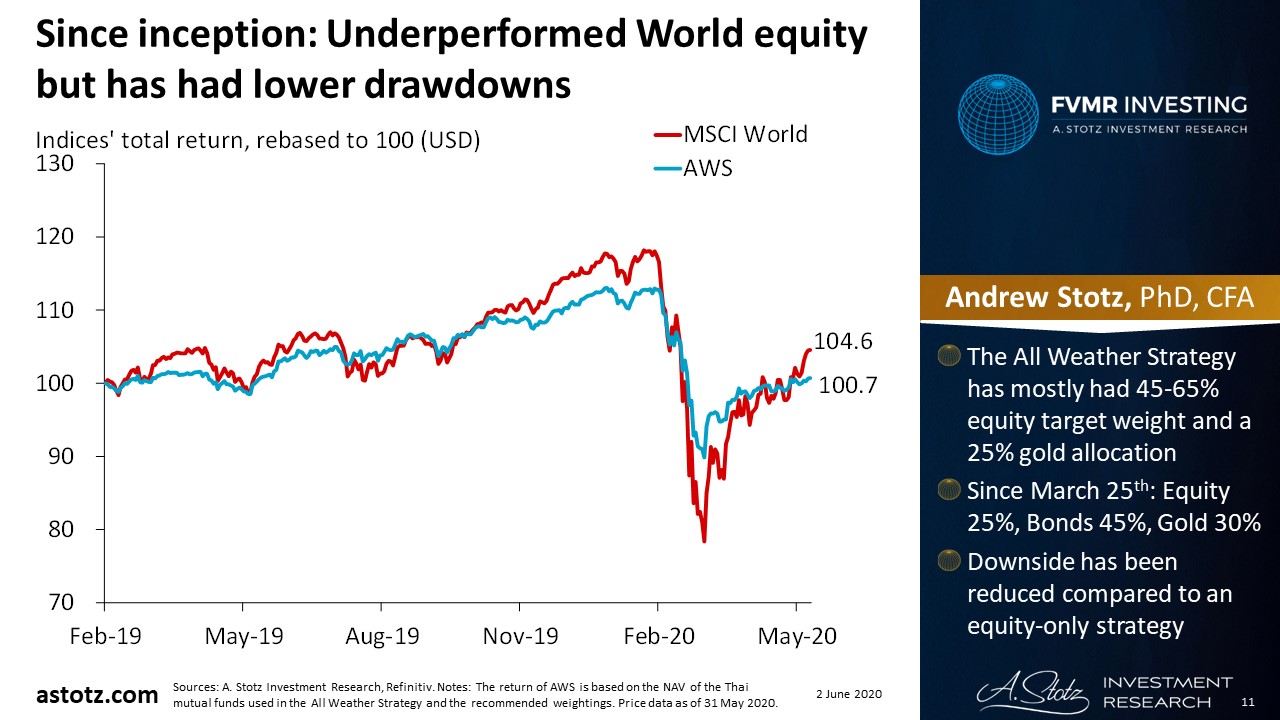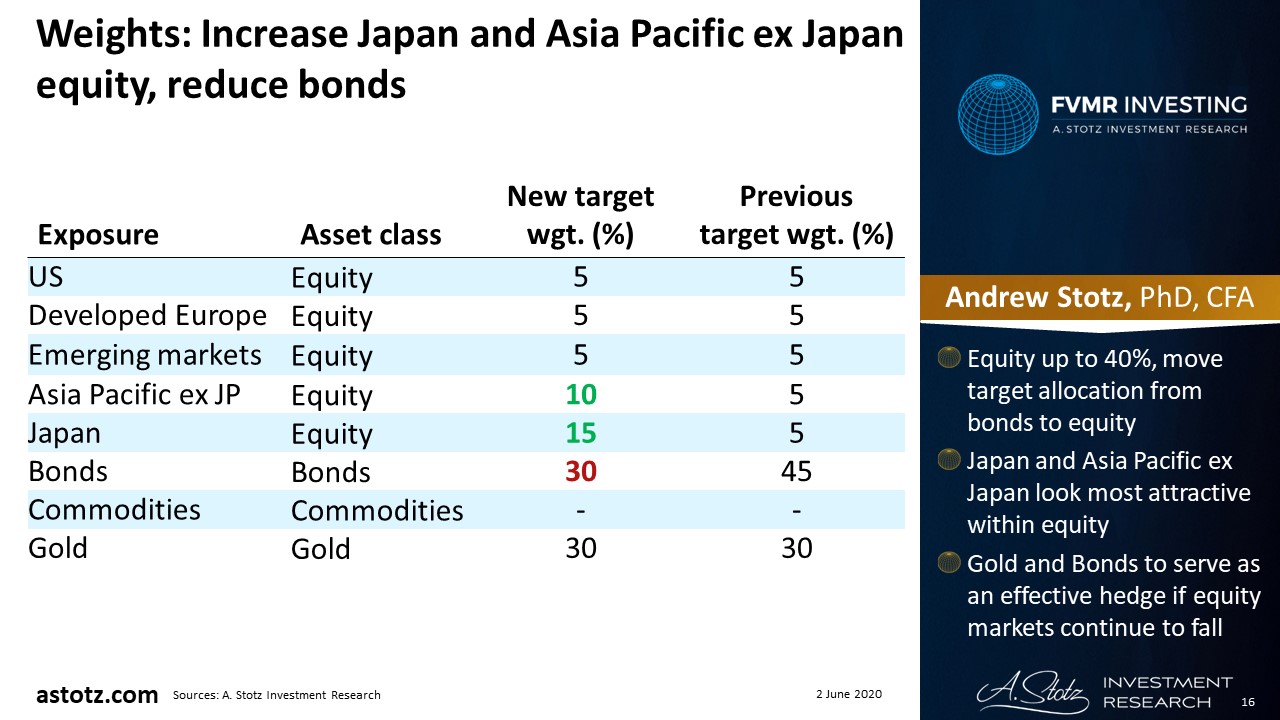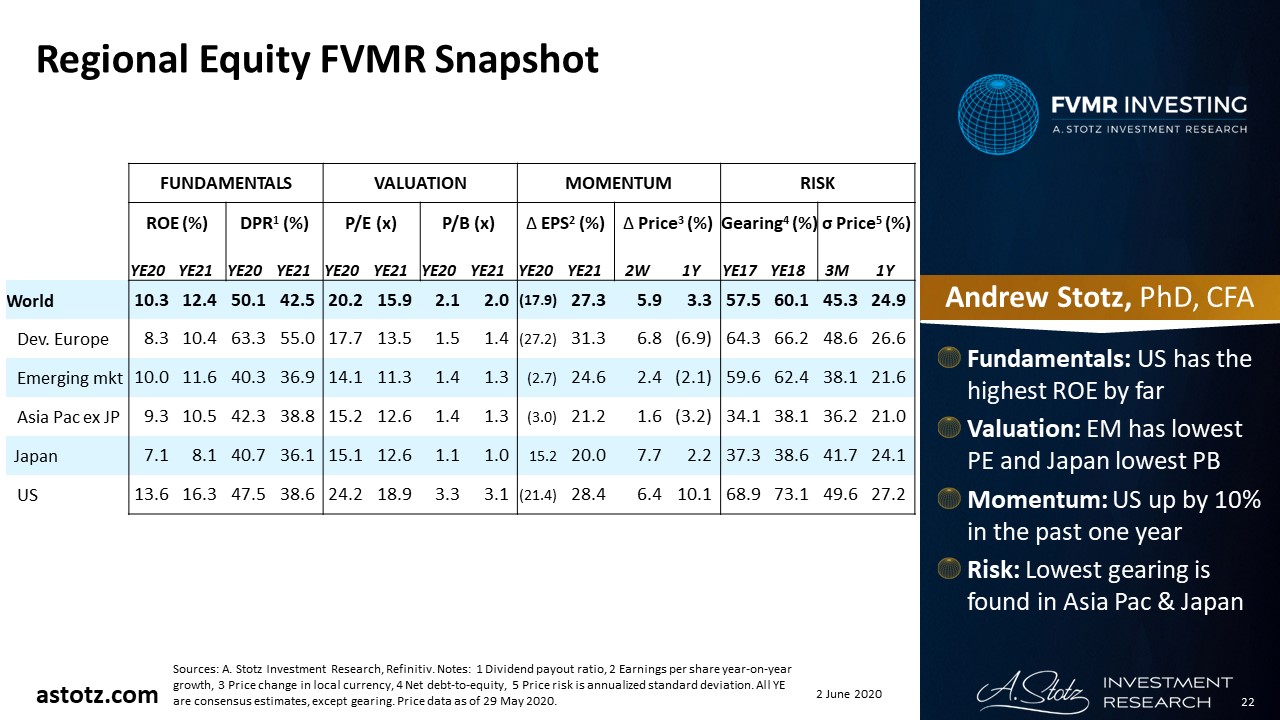A. Stotz All Weather Strategy – May 2020
We are now reducing the weight in bonds to 30% from 45%, with the allocation going back to equity. This raises our equity exposure to still a very low 40% from 25%. We still see the biggest risk in the US equity market and hence do not allocate any of this to US equity and keep it at 5%. Our primary aim is to limit the downside; therefore, we prefer defensive assets.
The A. Stotz All Weather Strategy is Global, Long-term, and Diversified:
- Global – Invests globally, not only Thailand
- Long-term – Gains from long-term equity return, while trying to reduce a portion of losses during equity market downturns
- Diversified – Diversified globally across four asset classes
The All Weather Strategy is available in Thailand through FINNOMENA. Please note that this post is not investment advice and should not be seen as recommendations. Also, remember that backtested or past performance is not a reliable indicator of future performance.
Review
Low equity allocation led to underperformance of the All Weather Strategy
- In March, we expected further downside from all-time-high valuations in equities, and we reduced our equity weight to 25% from 45%
- However, the equity market rebound that began at the end of March has continued
- Driven by Fed’s money printing and increased optimism about the COVID-19 pandemic peaking
- The low equity allocation did initially cushion the downside
- The US and other Developed markets have rebounded the most, but have not yet fully recouped their losses
- The equity rebound and our low equity allocation explain All Weather Strategy’s underperformance in the past three months
After the shift to Thai government bonds, return has stayed flat
- Previously we increased the bond allocation to 45% from 25%
- The reason for our increase of the bond target allocation and shift out of corporate bonds, was to limit equity and corporate bond downside risk
- That bond position has basically been flat since
- We also shifted the bond allocation to only Thai government bonds, rather than a mix of global government and corporate bonds
Commodities dragged down by oil
- Previously we cut our commodities exposure to zero and we maintain that position
- April 2020, marked the first time we saw a negative price on an oil future
- Commodities overall have rebounded, but still down in the past three months, we are looking for economic recovery as a driver
- The oil price has since recovered—as Saudi Arabia, the UAE, and Kuwait announced to cut output
Gold was the best performer in the past three months
- Previously we increased the target weight for gold to 30% from 25%, we maintain that position
- Continued uncertainty has supported investment demand for the yellow metal
- It has been the best performing asset in the past three months
Past 3 months: The All Weather Strategy underperformed as equity rebounded forcefully

Past performance should not be taken as an indication or guarantee of future performance, and no representation or warranty, expressed or implied is made regarding future performance.
- All Weather Strategy: Underperformed World equity by 2.4%
- Gold: Continued uncertainty drove the price
- Bonds: Fell with the rest of the market in February and March, stayed flat since our switch to Thai short-term government bonds
Since inception: Underperformed World equity but has had lower drawdowns

Past performance should not be taken as an indication or guarantee of future performance, and no representation or warranty, expressed or implied is made regarding future performance.
- The All Weather Strategy has mostly had 45-65% equity target weight and a 25% gold allocation
- Since March 25th: Equity 25%, Bonds 45%, Gold 30%
- The downside has been reduced compared to an equity-only strategy
Since inception: The All Weather Strategy has had less than half the volatility of World equity

Past performance should not be taken as an indication or guarantee of future performance, and no representation or warranty, expressed or implied is made regarding future performance.
- The volatility of All Weather Strategy has been less than half the volatility of World equity
- 25-65% target weight to equity has reduced volatility
- As gold is generally uncorrelated to equity, it has dampened the overall All Weather Strategy volatility
Since inception: Has lost less when World equity has fallen

Past performance should not be taken as an indication or guarantee of future performance, and no representation or warranty, expressed or implied is made regarding future performance.
- A key feature of the All Weather Strategy is that it aims to lose less when equity markets fall
- Looking at the 10 worst days of World equity since the inception of All Weather Strategy, the has strategy has lost less on every day so far
- Much due to low equity weight and gold allocation
Since inception: The All Weather Strategy has mainly outperformed when equity has suffered big drops

Past performance should not be taken as an indication or guarantee of future performance, and no representation or warranty, expressed or implied is made regarding future performance.
- Largest outperformance has been in the months of Mar-20, Feb-20, May-19, and Aug-19 when World equity fell the most
- Gold and bonds have served as an effective hedge in most of the down months
Weights
Raise target equity allocation to still a very low 40%
- We are now reducing the weight in bonds to 30% from 45%, with the allocation going back to equity
- This raises our equity exposure to still a very low 40% from 25%
- We still see the biggest risk in the US equity market and hence do not allocate any of this to US equity and keep it at 5% in the All Weather Strategy
Increase Japan and Asia Pacific ex Japan equity, reduce bonds

- Equity up to 40%, move target allocation from bonds to equity
- Japan and Asia Pacific ex Japan look most attractive within equity
- Gold and Bonds to serve as an effective hedge if equity markets continue to fall
Outlook
The stock market has recovered
- More countries start to either think they have the COVID-19 outbreak under control or have decided that now it’s time to re-open the economy
- Stock markets have recovered around the world, lead by the US
- But have the fundamentals improved since equities turned up in late March?
But fundamentals haven’t improved
- Earnings expectations have been slashed, and consensus EPS growth is at -17.8% for MSCI World in 2020E
- US jobless claims have passed 40m
- US-China conflict has resumed, Hong Kong riots have resumed, the US now has its own riots
- We maintain our negative view on the US–the money printer can’t go “brrr” forever
Move away from our ultra-conservative equity target allocation
- Building on the recent positive trend in equity, we increase the equity target allocation to 40% from our ultra-conservative 25%
- Japan and Asia Pacific ex Japan have relatively low gearing and are relatively cheap
- Japan could see inflows in turbulent times, as the Yen has a historic status as a safe haven
- We also see Asia as being the strongest growth engine post-COVID
We remain cautious and focus on downside protection
- We continue to focus on downside protection, even if it means lagging world equity in the short term
- We still see a risk of a second wave of COVID-19, which could quickly worsen the growth outlook
- And if the virus outbreak is over faster than expected, geopolitical tensions, mass unemployment, and debt issues remain
Gold and bonds still have heavy weights
- Re-opening of economies around the world come with restrictions; recovery may be slow
- Some businesses won’t open again, and spending patterns may change; full recovery may, therefore, take a very long time
- Our global growth outlook remains pessimistic
- Therefore, commodities remain unattractive
- We are still comfortable to overweight defensive assets; gold and bonds
Regional Equity FVMR Snapshot

- Fundamentals: US has the highest ROE by far
- Valuation: EM has the lowest PE and Japan the lowest PB
- Momentum: US up by 10% in the past one year
- Risk: Lowest gearing is found in Asia Pacific and Japan
DISCLAIMER: This content is for information purposes only. It is not intended to be investment advice. Readers should not consider statements made by the author(s) as formal recommendations and should consult their financial advisor before making any investment decisions. While the information provided is believed to be accurate, it may include errors or inaccuracies. The author(s) cannot be held liable for any actions taken as a result of reading this article.
